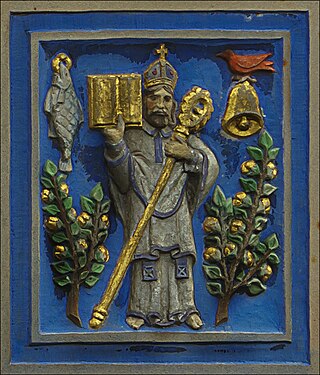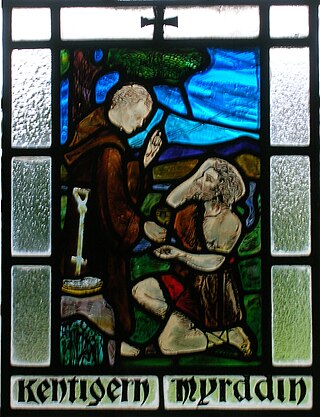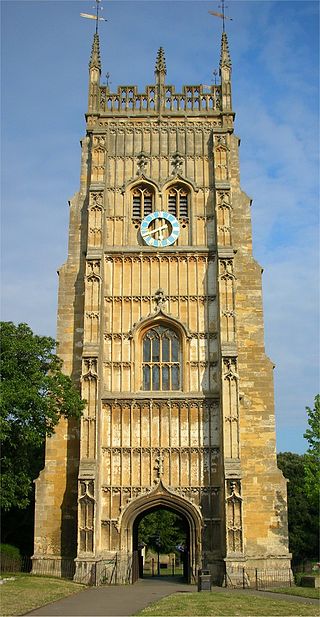Related Research Articles

Ninian is a Christian saint, first mentioned in the 8th century as being an early missionary among the Pictish peoples of what is now Scotland. For this reason he is known as the Apostle to the Southern Picts, and there are numerous dedications to him in those parts of Scotland with a Pictish heritage, throughout the Scottish Lowlands, and in parts of Northern England with a Northumbrian heritage. He is also known as Ringan in Scotland, and as Trynnian in Northern England.

Kentigern, known as Mungo, was a missionary in the Brittonic Kingdom of Strathclyde in the late sixth century, and the founder and patron saint of the city of Glasgow.

Stephen of Ripon was the author of the eighth-century hagiographic text Vita Sancti Wilfrithi. Other names once traditionally attributed to him are Eddius Stephanus or Æddi Stephanus, but these names are no longer preferred or accepted by historians today; modern usage tends to favour "Stephen".
Saint Serf or Serbán (Servanus) is a saint of Scotland. Serf was venerated in western Fife. He is called the apostle of Orkney, with less historical plausibility. Saint Serf is connected with Saint Mungo's Church near Simonburn, Northumberland. His feast day is 1 July.

Myrddin Wyllt is a figure in medieval Welsh legend. In Middle Welsh poetry he is accounted a chief bard, the speaker of several poems in The Black Book of Carmarthen and The Red Book of Hergest. He is called Wyllt—"the Wild"—by Elis Gruffydd, and elsewhere Myrddin Emrys ("Ambrosius"), Merlinus Caledonensis or Merlin Sylvestris("of the woods"). Myrddin Wylt was born in 540 CE.

King Lot, also spelled Loth or Lott, is a British monarch in Arthurian legend. He was introduced in Geoffrey of Monmouth's pseudohistorical Historia Regum Britanniae as King Arthur's brother-in-law, who serves as regent of Britain between the reigns of Uther Pendragon and Arthur. He has appeared regularly in works of chivalric romance, alternating between the roles of Arthur's enemy and ally, and is often depicted as the ruler of Lothian and either Norway or Orkney. His literary character is probably derived from hagiographical material concerning Saint Kentigern, which features Leudonus as king of Leudonia and father of Saint Teneu.
Lailoken was a semi-legendary madman and prophet who lived in the Caledonian Forest in the late 6th century. The Life of Saint Kentigern mentions "a certain foolish man, who was called Laleocen" living at or near the village of Peartnach (Partick) within the Kingdom of Strathclyde. Laleocen correctly prophesied the death of King Rhydderch Hael.

Yvain, the Knight of the Lion is an Arthurian romance by French poet Chrétien de Troyes. It was written c. 1180 simultaneously with Lancelot, the Knight of the Cart, and includes several references to the narrative of that poem. It is a story of knight-errantry, in which the protagonist Yvain is first rejected by his lady for breaking a very important promise, and subsequently performs a number of heroic deeds in order to regain her favour. The poem has been adapted into several other medieval works, including Iwein and Owain, or the Lady of the Fountain.
This is a bibliography of works about King Arthur, his family, his friends or his enemies. This bibliography includes works that are notable or are by notable authors.

The Archdiocese of Glasgow was one of the thirteen dioceses of the Scottish church. It was the second largest diocese in the Kingdom of Scotland, including Clydesdale, Teviotdale, parts of Tweeddale, Liddesdale, Annandale, Nithsdale, Cunninghame, Kyle, and Strathgryfe, as well as Lennox, Carrick and the part of Galloway known as Desnes.

Saint Asaph was, in the second half of the 6th century, the first Bishop of St Asaph, i.e. bishop of the diocese of Saint Asaph.

Saint Kentigern College is a private co-educational Presbyterian secondary school in the suburb of Pakuranga on the eastern side of Auckland, New Zealand, beside the Tamaki Estuary. It is operated by the Saint Kentigern Trust Board which also operates Saint Kentigern Boys' School, Saint Kentigern Girls' School and Saint Kentigern Preschool.

Rhydderch Hael, Riderch I of Alt Clut, or Rhydderch of Strathclyde, was a ruler of Alt Clut, a Brittonic kingdom in the Hen Ogledd or "Old North" of Britain. He was one of the most famous kings in the Hen Ogledd, and appears frequently in later medieval works in Welsh and Latin.

Teneu is a legendary Christian saint who was venerated in medieval Glasgow, Scotland. Traditionally she was a sixth-century Brittonic princess of the ancient kingdom of Gododdin and the mother of Saint Mungo, apostle to the Britons of Strathclyde and founder of the city of Glas Ghu (Glasgow). She and her son are regarded as the city's co-patrons, and Glasgow's St Enoch Square allegedly marks the site of a medieval chapel dedicated to her, built on or near her grave. She is commemorated annually on 18 July.
Jocelyn of Furness was an English Cistercian hagiographer, known for his Lives of Saint Waltheof, Saint Patrick, Saint Kentigern and Saint Helena of Constantinople. He is probably responsible for the popular legendary association of Saint Patrick with snakes, which he purportedly cast out of Ireland.

Dominic of Evesham was a medieval prior of Evesham Abbey in England and writer of religious texts. Probably a native Englishman, there is some confusion about when he became a monk, but by 1104 he was at Evesham and by 1125 he held the office of prior. He is chiefly known for his religious works, including one on the miracles of the Virgin Mary that was an important source for later writings on the subject. Four of his works are still extant.
The Vita Sancti Niniani or simply Vita Niniani is a Latin language Christian hagiography written in northern England in the mid-12th century. Using two earlier Anglo-Latin sources, it was written by Ailred of Rievaulx seemingly at the request of a Bishop of Galloway. It is loosely based on the career of the early British churchman Uinniau or Finnian, whose name through textual misreadings was rendered "Ninian" by high medieval English and Anglo-Norman writers, subsequently producing a distinct cult. Saint Ninian was thus an "unhistorical doppelganger" of someone else. The Vita tells "Ninian's" life-story, and relates ten miracles, six during the saint's lifetime and four posthumous.

St Kentigern's Church,, is in the village of Caldbeck, Cumbria, England. It is an active Anglican parish church in the deanery of Carlisle, the archdeaconry of Carlisle and the diocese of Carlisle. The church is recorded in the National Heritage List for England as a designated Grade I listed building. It is dedicated to Saint Kentigern, whose alternative name is Saint Mungo; hence the church's alternative title of Caldbeck, St Mungo.
Reginald of Canterbury was a medieval French writer and Benedictine monk who lived and wrote in England in the very early part of the 12th century. He was the author of a number of Latin poems, including an epic entitled Malchus, which still survives.

Kirkmahoe is a civil parish in Dumfries and Galloway. The parish contains the settlements Kirkton, where the parish church is located, Dalswinton and Duncow. It is bounded by the parishes of Dumfries to the south, Holywood and Dunscore to the west, and Kirkmichael and Tinwald to the east.
References
- ↑ Hnutu-healh, Glyn (2021-05-31). "Vita Sancti Kentigerni (Life of Saint Kentigern)". MythBank. Retrieved 2022-10-23.
- ↑ Jocelin, active 1200. "Vita Sancti Servani and Vita Sancti Kentigerni : [Lives of St Sert and St Kentigern/ Mungo] /". www.marshlibrary.ie. Retrieved 2022-10-23.
{{cite web}}: CS1 maint: numeric names: authors list (link)